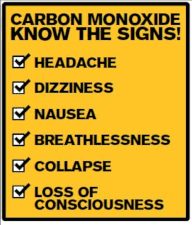
Carbon Monoxide (CO) and Propane
Carbon Monoxide (CO) is responsible for almost 25% of all propane related fatalities. Carbon Monoxide is the product of incomplete gas combustion often because appliances are improperly adjusted. Properly functioning propane appliances will produce what is called an "ideal burn" during combustion and present no danger of Carbon Monoxide poisoning. Carbon Monoxide poisoning can lead to severe injury and even death.
Propane Combustion Requirements
Three ingredients required for combustion to take place include fuel, ignition and air. Without any one of these three ingredients, combustion will not occur and even still, the ratio of air to gas must be within an acceptable range for combustion to occur. For instance, a mixture made up of equal parts propane and air will not combust when ignition is introduced. With propane, combustion will occur when the gas in air mixture is between 2.2 and 9.6 and is referred to as the "limits of flammability". In other words, 2.2 parts propane and 97.8 parts air is a combustible mixture as is 9.6 parts propane and 90.4 parts air. Combustion will occur anywhere between these two gas to air ratios with the "ideal burn" being about 4 parts propane and 96 parts air (1:24). This ideal ratio is considered to be the most efficient burn of propane gas when used. Complete combustion of propane is evident by a blue burning flame.
Incomplete Propane Combustion - Lean and Rich Burn
Carbon Monoxide is produced during the incomplete combustion of propane. Incomplete combustion is defined as within the limits of flammability but higher or lower than the ideal ratio of 4 parts propane 96 parts air. Incomplete propane combustion can occur in one of two ways:
- Propane Lean Burn - The ratio of propane to air is less than 4 parts propane. 2.5 parts propane to 97.5 parts air would produce a lean burn. A lean burn can be recognized when flames appear to lift away from the burner and can potentially go out.
- Propane Rich Burn - A ratio of propane to air is more than 4 parts propane. 8.5 parts propane to 91.5 parts air would produce a rich burn. Recognizing a rich burn is very simple as the flames are much larger than they are supposed to be and are largely yellow in color.
Several products of incomplete combustion that are easily visible and if noticed, action should be taken immediately. Visible signs of incomplete combustion include burner flame appearance (as listed above), soot collecting on appliance windows such as that of a space heater and excessive water vapors forming on windows and cool surfaces during appliance operation. Appliance service and adjustment is needed if any of these visible signs of incomplete combustion are noticed.
 Dangerous Levels of Carbon Monoxide - The Signs
Dangerous Levels of Carbon Monoxide - The Signs
Carbon Monoxide is a deadly toxic gas undetectable by smell that can harm or kill animals, plants and people. Carbon Monoxide poisoning is not limited to propane gas. It is a product of the incomplete combustion of natural gas as well. The best defense against Carbon Monoxide poisoning is to have working CO detectors installed throughout the living space of a home. Carbon Monoxide detectors are available at many stores as well as on the internet. If any of the following signs are noticed, take action immediately as a high level of Carbon Monoxide is likely present.
- Aldehydes - This toxic gas is detectable by smell and gives the sensation of a metallic taste in ones mouth after exposure and indicates Carbon Monoxide is most likely present.
- Health Symptoms - Carbon Monoxide poisoning causes headaches, dizziness, nausea, shortness of breath and light-headedness. Fresh air is needed immediately followed by medical attention.
- Dead Plants - Dangerous levels of Carbon Monoxide are likely if the plants in your home have all of a sudden died or are withering.
Action needs to be taken immediately if any or combination of the above are noticed!
